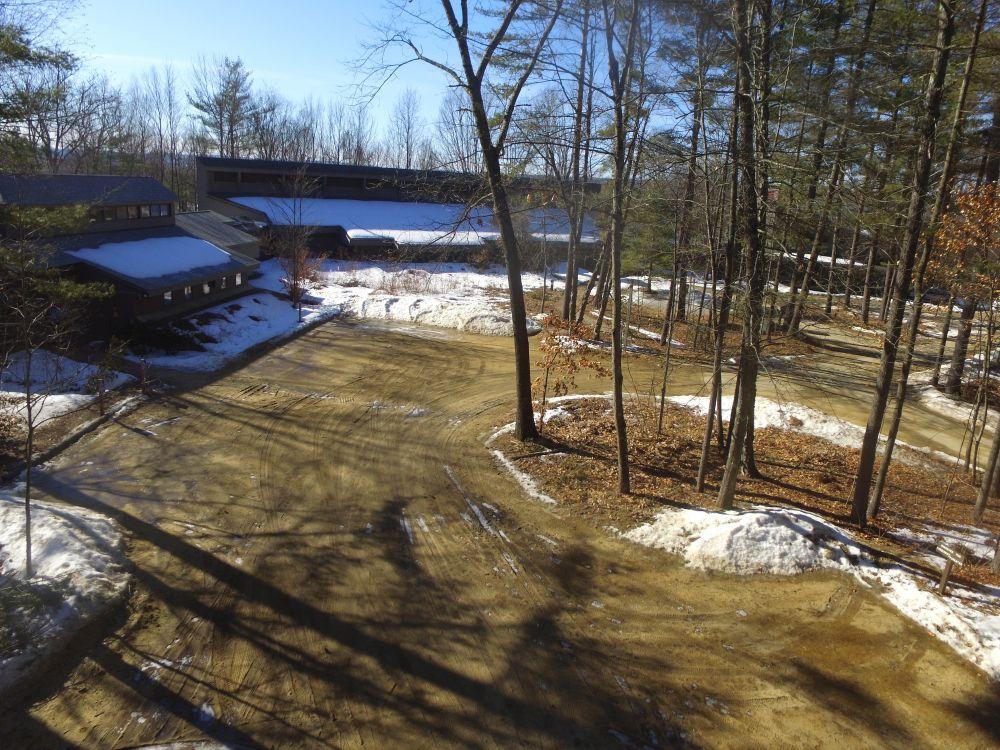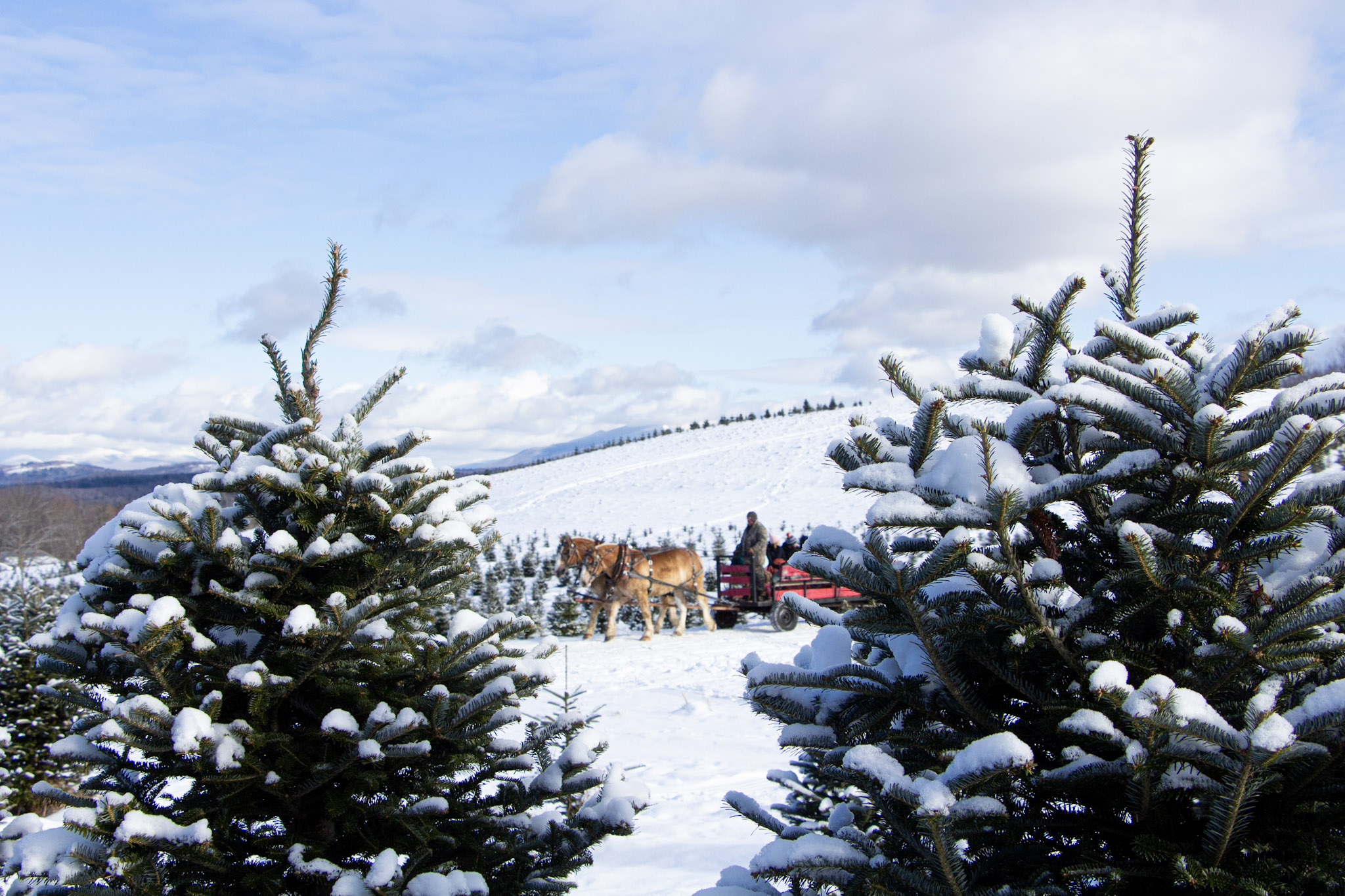There's more to know about 'urban' trees
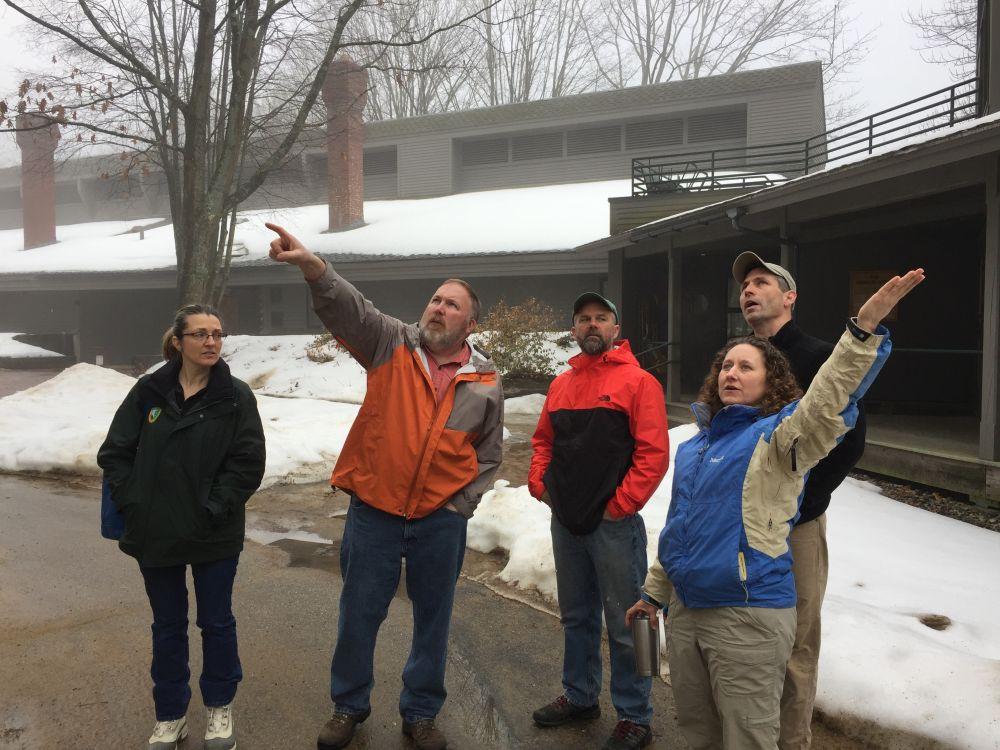
Urban foresters AJ Dupere, Scott Rolfe and Heather Green advise Forest Society staff. Photos Dave Anderson
What did ‘in the woods’ foresters learn from their colleagues working in cities and suburbs?
Look out your window- what do you see? Roads? Trees? Buildings? Forested mountains? In NH, it could be some of each.
We naturally think of forests as wildland, open space. What about forests growing around our homes and offices? Which trees are best adapted for built neighborhoods with lawns, sidewalks, roads and parking lots? There’s an entire branch of forestry dedicated to managing ‘street trees’ growing adjacent to city streets or in suburban backyards.
The Forest Society Concord Conservation Center campus includes 103 acres of wetlands, forest and hiking trails with direct frontage on the Merrimack River. It’s also a busy office complex with buildings, driveways, utilities, outdoor lighting and snow removal.
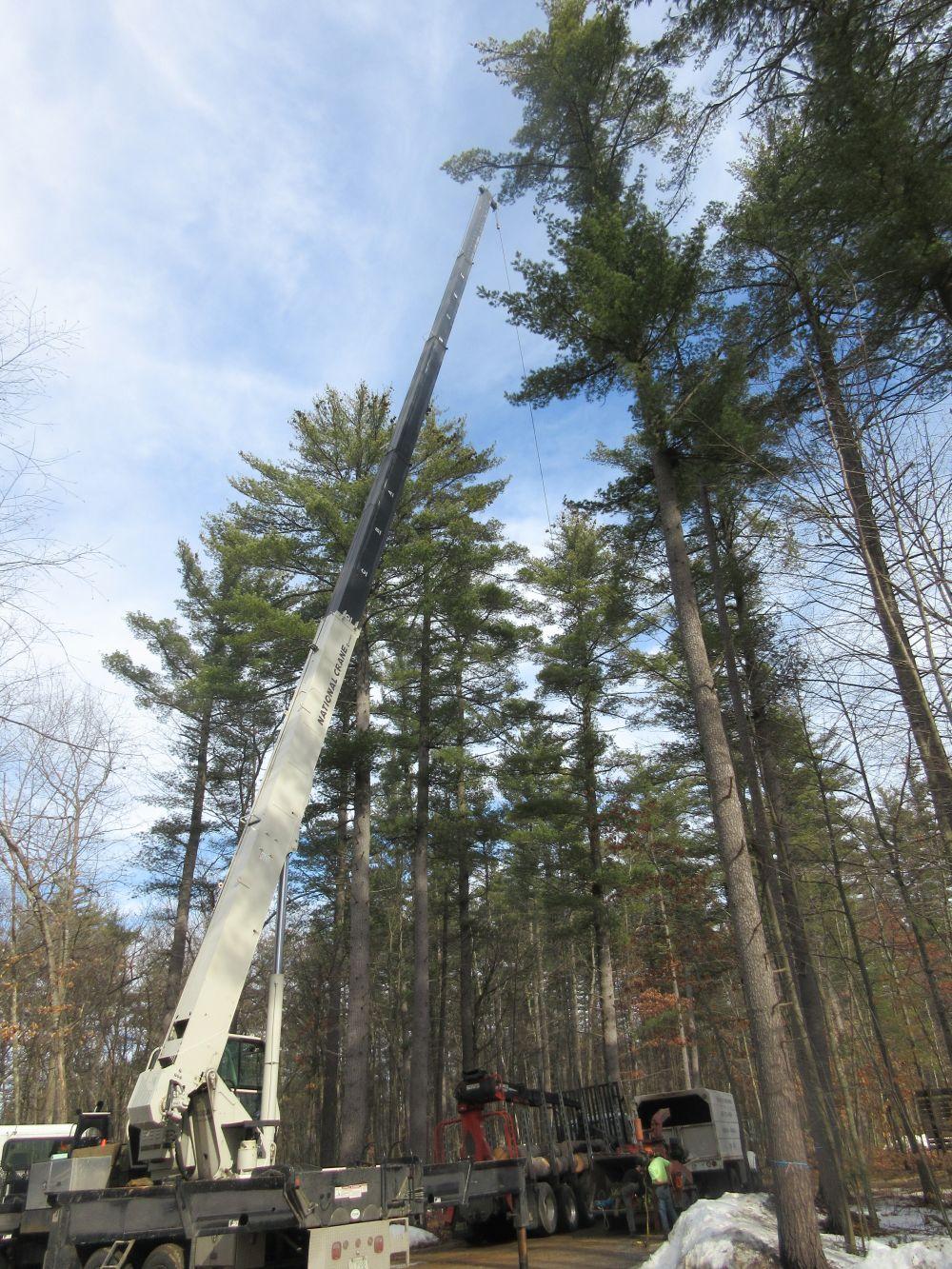
Arborists from Top Notch Tree Service recently removed several high-risk 80-foot tall mature white pines using a 120-foot crane. With the new influx of sunlight, the landscape surrounding buildings and parking lots will change. The sandy, dry soil of the bluff overlooking the Merrimack is best adapted to growing oak and white pine which currently grow on site. We need to plan for the future forest surrounding the office we affectionately call “the treehouse”
On-staff foresters manage 56,000 acres on 180 permanent Forest Reservations statewide. But we don’t have urban forestry expertise: selecting and maintaining urban shade trees. We sought help thinking outside the forest. As a professional courtesy, NH Division of Forests and Lands urban forestry experts AJ Dupere, Scott Rolfe and Heather Green walked the perimeter of our buildings and parking lots to share considerations for care of mature trees and advice for planting new ones. The community forestry team also made recommendations for developing a long-range tree planting plan.
The best time to plant trees is yesterday… or maybe twenty years ago.
The experts shared tree health considerations. Their best advice is to provide ample space for roots and tree crowns to expand. The underground root spread is a direct 1:1 ratio to the spread of canopy branches overhead. Urban trees planted in a too-shallow or too-narrow root well don’t provide space for root expansion. Stressed trees become more susceptible to drought and insect damage. Consider the mature size of plantings. A 60’ tall tree requires 40’ of space for the canopy to spread laterally. Heather Green advises: “Don’t try to make trees fit into a space. Overhead powerlines, roads, sidewalks, and maintaining adequate distances from buildings requires proper planning.”
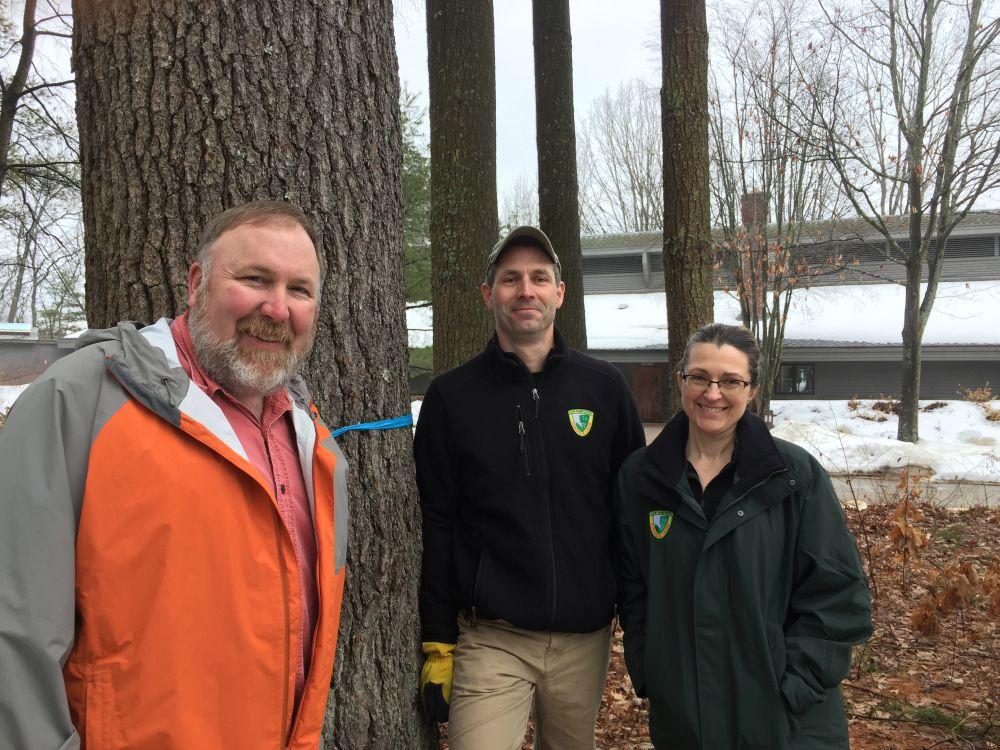
Scott Rolfe adds “While larger trees provide the most ecosystem services in terms of cooling, shade, and rain interception, you generally don’t want trees arching over your roof.” Roofs need air and sunlight to melt snow, dry out and prevent rot. Rain gutters that fill with fallen leaves require maintenance. “Lower branches of trees located close buildings can be pruned to channel growth into the uppermost branches to raise the crown” adds Dupere.
Don’t forget about snow storage and possible damage from snow plowing. Dupere warns “Snowplows, weed-whackers and lawn mowers do the most damage to street trees. A perfect, green lawn kills trees.” Trees in urban or suburban environments take up more chemicals. Weed-killers and road salts affect the health of trees which are salt intolerant. Dupere says “Sugar maples remain popular with New Englanders but they are not a good choice for urban planting. I recommend red maple or silver maple. We have too many maples! Pin oak and London Plane tree are better choices- they withstand abuse, salt and pollution.” Ginko is pollution-tolerant tree but can be messy. Other popular street tree varieties include ornamental flowering crabapple, Bradford pear and flowering cherry. Black cherry is prone to a black knot disease and is not recommended.
Conifers provide more shade and add privacy when planted as a hedge. The experts recommend white spruce rather than blue spruce which exhibits “needle cast” creating bald spots. Native hemlock is a good cold-hardy choice for acidic soil. Norway spruce is a big beautiful tree but requires a lot of space. “In open lawns or park settings, Norway spruce can grow 50’ wide.” Northern white cedar and Eastern red cedar are cold hardy but die-back if covered by heavy snow. The “arborvitae” cedars require burlap and stakes to keep them from becoming buried and flattened by snow. Yew makes a great hedge but browsing deer make it an impractical choice without deer fencing.
Heather Green’s key considerations for choosing appropriate trees include sanitation for litter-fall – leaves, twigs and acorns that accumulate on lawns and driveways. Pines drop needles, cones and drip sticky pitch. Butter helps remove pine pitch from car windshields, roofs and hoods. Green recommends people plant sooner rather than later and consider planting smaller trees. “Smaller trees are less expensive, easier to plant and grow faster. A two inch caliper tree with a smaller root ball will become established in two years whereas a four inch caliper tree can take four years to establish. “With ample water, new plantings establish quickly and are no longer in intensive care.”
Urban and community foresters are passionate about mulch: too much, too little, wrong kind. Dupere stresses that all mulch is not the same. “Red or black colored mulch is often a dyed product made from ‘bole wood.’ It is 100% cellulose and lignin from tree trunks. The bacteria that decompose cellulose suck the nitrogen out of soil. It is better to use a natural mulch of fine materials: twigs and leaves. It degrades faster.” Dupere advises to avoid any kind of colored mulch that could contain construction waste. “Some colored mulch sold at garden centers contain pelletized pallet wood. Other mulches contain bio-solids such as ‘Millorganite’ made from processed sewerage solids. ‘Super-loam’ is usually bio-solids that can contain heavy metals and even pharmaceuticals. When landscapers mix-in mulch containing bio-solids into woodchips it can cause skin rashes.” Mulch should be labelled. “Read the label” Dupere stresses.
The urban and community forestry team shared an expression: “The best time to plant trees is yesterday… or twenty years ago.” While the calendar says “winter” for a few more days, next month will bring Arbor Day and Earth Day. Traditionally, once snow melts and sun warms greening lawns and emerging leaves, residents are anxious to start gardening. Right now is the best time to plan for spring planting of trees and shrubs.
After the long winter and recent March snowstorms, Spring might just finally be around the corner?
